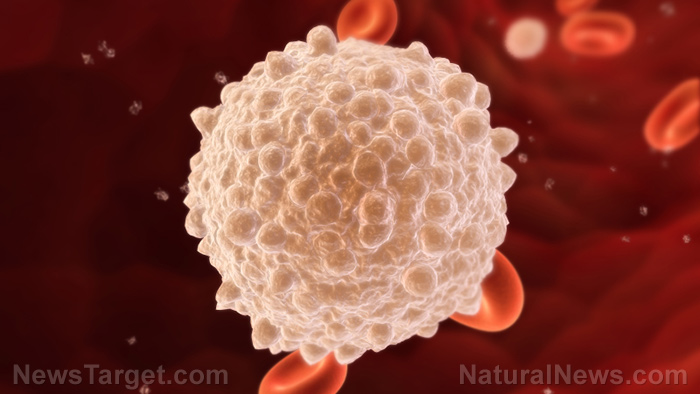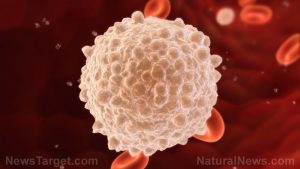
Leukemia – causes, side effects and treatments at NaturalPedia.com
Thursday, May 24, 2018 by Ralph Flores
http://www.naturalpedia.com/leukemia-causes-side-effects-and-treatments-at-naturalpedia-com.html

The term leukemia refers to a cancer of the white blood cells – the part of the immune system tasked to help the body fight infections. If a person has leukemia, the bone marrow, which creates both red and white blood cells, produce abnormal white blood cells. In time, these multiply and crowd out healthy blood cells, making it difficult for blood cells to function normally.
Different types of leukemia include the following.
- Acute lymphocytic leukemia (ALL) is common in young children, but it can also occur in adults.
- Acute myelogenous leukemia (AML) is typically seen in adults, but it can still affect children.
- Chronic lymphocytic leukemia (CLL) is the most common chronic adult leukemia in adults, where a person may feel well without the need for treatment.
- Chronic myelogenous leukemia (CML) is another type of leukemia seen in adults, with little to no symptoms indicating the initial stages of the disease.
Depending on the type, leukemias can develop rapidly or slowly. Chronic leukemia, for instance, grows slowly, while acute leukemias – usually seen in children – are abnormal and can develop quickly. There are a number of treatment options for the disease; however, long-term therapy may be required to prevent a relapse.

Known risk factors and symptoms of leukemia
The following are risk factors for leukemia:
- Those who have had previous cancer treatments that included certain types of chemotherapy and radiation therapy are at an increased risk of developing the disease.
- Genetic disorders, such as Down syndrome, increase the risk of developing certain types of leukemia.
- Exposure to chemicals like benzene, found in gasoline and used by the chemical industry, also increases a person’s likelihood of getting the disease.
- Smoking cigarettes is linked to the increase in acute myelogenous leukemia for adults.
- If a person has a family history of leukemia, his chances of getting the condition are also increased.
There are varying symptoms of leukemia – these would mainly depend on which type a person has.
- Fevers or chills
- Weakness and fatigue
- Sudden and unexplained drop in weight
- Frequent or severe infections
- Easy bleeding
- Swollen lymph nodes
- Recurring nosebleeds
- Petechiae, tiny red spots in the skin
- Bone pain or tenderness
- Excessive sweating
Body systems affected by leukemia
Leukemia affects the production of normal blood cells. CLL, in particular, can transform into an aggressive form of leukemia in a process known as a Richter transformation. Another complication of CLL is autoimmune hemolytic anemia, wherein the body attacks and destroys its own red blood cells.
Treatment can also result in a condition known as tumor lysis syndrome (TLS), a condition characterized by increased levels of uric acid, potassium, and phosphate following the death of cancer cells. In children, ALL treatment may lead to complications that impair the central nervous system (CNS), slow down growth, and even result in infertility.
Leukemia can also increase the risk of other types of cancer.
Food items or nutrients that may prevent or relieve leukemia
Having a healthy diet is a certain way to reduce a person’s chances of getting leukemia. In particular, consuming fruits that are packed with antioxidants will greatly improve the body’s chances of fighting cancer.
- Eating at least 10 fruits and vegetables a day ensures that the body gets the vitamins, minerals, antioxidants, and phytochemicals it needs to fight cancer cells. Try to add peaches, blackberries, apples, and strawberries as a snack during the day.
- Steaming your vegetables ensures that you get the most nutrients from them. Some vegetables to steam include mushrooms, broccoli, carrots, as well as steamed sweet peas, cauliflower, and zucchini – to name a few.
- Filling up on probiotics helps the stomach better handle food, especially during treatment.
If a person has leukemia, he must try to eat at least small snacks or meals every two to four hours to maintain his weight and stay strong.
Treatment and management options for leukemia
A person with leukemia has various treatment options, depending on his age, state of overall health, type of leukemia, and the amount that it has spread to other parts of the body.
Usual treatment options include:
- Chemotherapy. This treatment uses chemicals to kill cancer cells.
- Radiation therapy. X-rays and other high-energy beams are used to prevent the spread of leukemia.
- Stem cell transplant. A healthy bone marrow is transplanted to replaced a diseased one.
Where to learn more
- Dandelion root extract found to kill leukemia cells, prostate cancer cells and chemo-resistant melanoma
- Avocados naturally treat leukemia, but FDA and officials deny existence of ‘anticancer’ foods
- GMOs linked to blood cell disorders, leukemia: New study
- Aspartame is linked to leukemia and lymphoma in new landmark study on humans
- Natural sulforaphane compound from crucifers found effective to treat common form of leukemia
Summary
Leukemia refers to a cancer of the white blood cells – the part of the immune system tasked to help the body fight infections. Depending on the type, it can develop rapidly or slowly.
Leukemia affects the production of normal blood cells. It can also increase the risk of other types of cancer.
The chances of getting leukemia are reduced with a healthy diet.
Sources include:
Tagged Under: Tags: leukemia





